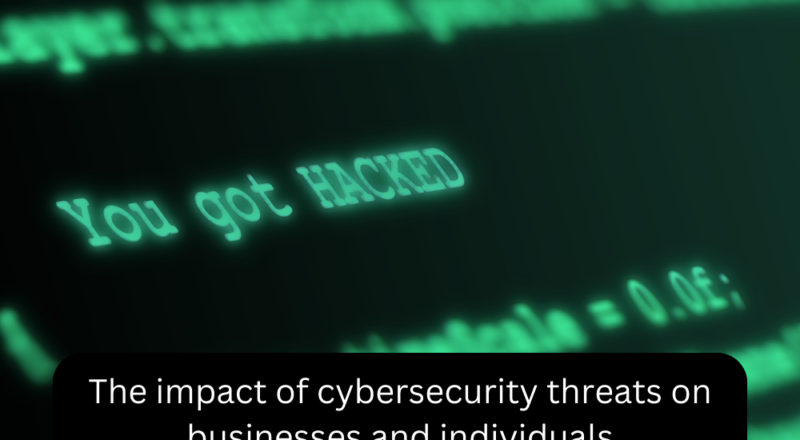Cybersecurity is an absolute necessity for any organization, whether big or small. The widespread adoption of Internet communication channels has made cybersecurity a pressing concern for everyone. In this day and age, when so much of our daily lives now take place online, it’s essential. While doing things online has simplified many aspects of our life, it also risks the confidentiality of our personal information. The fallout from such a disclosure might be catastrophic. Using a password manager and enabling multi-factor authentication (MFA) are useful productivity tips that can help businesses mitigate cybersecurity threats. The cost of responding to a cyber assault can be so high that it puts some small businesses out of business. Disruption to a company’s operations might lead to a steep drop in earnings.
The Effects of Cybercrime on Companies

More and more information about companies and their consumers is being stored digitally, making them easy targets for hackers. Cybersecurity expenses rise when companies have to defend themselves against cybercriminals, and those costs may be passed on to customers.
According to Hiscox, a business insurer, cybercrime cost companies $1.8 billion in 2019. Generally, companies are at risk, but those with a large online presence are prime targets. Most of the damage was sustained by energy, banking, manufacturing, technology, and pharmaceutical businesses. Some of the most significant ways in which cybercrime is currently affecting businesses are discussed below.
1. Soaring Prices
It will cost money, but businesses can protect themselves from cybercriminals. Expenses that businesses could face include, but are not limited to,
- Knowledge and tools for cyber security
- disclosure to affected parties
- Premiums for insurance
- Facilitation of Public Relations
Ransomware is a serious financial risk because it can block employees from using IT systems unless a hacker pays a ransom. Hiscox estimates that $381 million will be lost this year due to the 6% of businesses that paid a ransom.
2. Trouble in Operations
Indirect expenses, such as the likelihood of a severe interruption to operations and subsequent lost revenue, are a common consequence of cyberattacks for businesses and direct monetary damages.
Infecting computer systems with malware that deletes high-value information or placing malicious code on a server that limits access to your website are just two examples of how cybercriminals can stifle a company’s usual activity.
So-called “hacktivists,” who have broken into the computer networks of government agencies or multinational corporations to expose a perceived wrong or enhance transparency, embrace disrupting business as usual as their preferred tool. For example, in 2010, hackers sympathetic to WikiLeaks launched assaults on Mastercard and Visa, momentarily taking down their websites.
3. Shifted Methods of Doing Business
The effects of cybercrime on enterprises extend far beyond the monetary. To prevent sensitive data from being compromised, businesses must reevaluate their data collection and storage practices. Spoofing and phishing attacks are a major cybersecurity threat to businesses, as they can trick employees into revealing sensitive information or downloading malware. Many businesses no longer store credit card numbers, Social Security numbers, and dates of birth.
Due to the high risk of cyber attacks, several businesses have abandoned online stores. Customers are more curious about the security practices of the companies they do business with, and they are more likely to support those companies who are transparent about the safeguards they have put in place.
Read: Advantages and Disadvantages of Web Application
4. Damage to Your Reputation
Although difficult to measure precisely, the damage to a company’s reputation due to a major cyberattack can be substantial. If a company’s IT has already been breached at least once, customers and suppliers may hesitate to entrust their private data to them.
The 2013 data breach at retail giant Target (TGT) exposed the credit card information of more than 40 million consumers and cost the company $18.5 million to settle, severely damaging the company’s reputation. Criminals hacked into the customer databases of rival bank JPMorgan Chase & Co. (JPM) in 2014. Information on 76 million homes and 7 million small businesses was compromised, including names, addresses, phone numbers, and email addresses.
5. Lost Profits
The loss of revenue due to wary clients taking their business elsewhere is among the worst possible cyberattack results. Hackers that attempt extortion against businesses can cause financial harm as well.
For Instance: While preparing to broadcast “The Interview,” a comedy about an assassination attempt on North Korean leader Kim Jong Un, Sony Pictures was attacked in 2014. Its employees’ embarrassing emails and performance reviews were among the data stolen by hackers.
6. Theft of Confidential Information
The intellectual property of a company’s products, technologies, and distribution methods can be extremely valuable. According to intellectual property advice firm Ocean Tomo, intangible assets made up 87% of the value of S&P 500 firms in 2015.
Most of this intellectual property is kept in cloud storage, open to cyber threats. About 30% of American businesses in the last decade say a Chinese competitor stole their intellectual property.
Types of Online Threats
The following are examples of prevalent online dangers:
- Phishing sends fictitious messages to get sensitive information (such as passwords) via electronic mail. They may even pose as officials from reputable institutions like government offices or multinational corporations.
- Malware is malicious software cybercriminals use to steal personal information, hold your system or device for ransom, or secretly install other harmful programs.
- Ransomware is a form of malware that encrypts your data and refuses to decrypt it unless you pay a ransom.
Tips for preventing cybercrimes at your company
The following best practices should be implemented immediately to protect yourself and your company from a wide range of cybercrimes:
1. Always update your information
Regularly, hackers will try to break into your system by exploiting security holes in your program or OS. A serious data breach caused by a flaw in an application that a security update has already patched is the last thing you must worry about.
Maintain a consistent routine of updating your software and operating systems, especially your internet security software (antivirus).
2. Use a secure, one-of-a-kind password.
Passwords should be lengthy (at least ten characters) and complicated (using a mix of at least ten letters, numbers, and symbols). Please avoid using the same password for many sites, and switch them up frequently.
Password management solutions allow users to create and “remember” secure, complicated passwords easily.
3. Implement dependable safety measures.
It would help if you used security software solutions to defend your company from the vast range of cybercrimes, such as but not limited to:
- Useful antivirus and anti-malware software, preferably with artificial intelligence-powered behavioral detection technologies.
- A real-time solution to detect and counteract dangerous bots on your network.
- Automated takedown requests and real-time monitoring for trademark and copyright infringements: that’s the Real-Time Brand Protection Solution.
4. Train and instruct your staff.
The security of your company is only as good as its weakest link. A single hacked worker can serve as a backdoor for cybercriminals to get access to the rest of your network. Boost your eCommerce sales by mitigating cybersecurity threats to your business and protecting your customers’ data. Include cybersecurity training as a required component of employee onboarding, and make regular updates to the training program to account for changes in cybersecurity.
Be extremely wary of phishing attempts. Training your staff and consumers to identify phishing attempts and respond appropriately is important.
Conclusion
Today, not only do large corporations face the threat of cybercrime, but so do SMBs, sole proprietors, and even individuals. Therefore, it is the responsibility of each individual to take measures to prevent being a victim of cybercrime. By leveraging Digital Transformation Services and practicing our advice, you’ll be well-equipped to defend yourself and your company against cyber criminals. We appreciate your visit.
